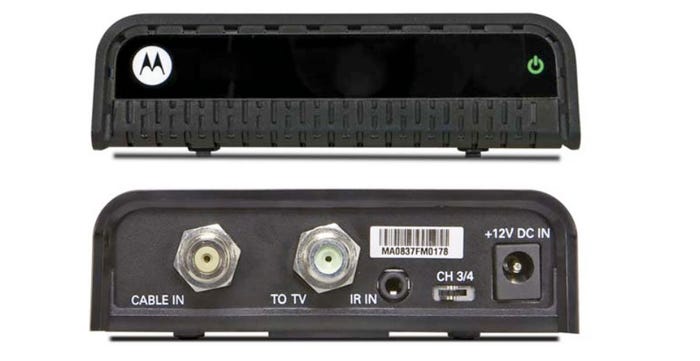Cable ops starting to shut down legacy QAM video to make room for broadband
Mediacom has shut down its legacy QAM video and Midco and Cox plan to follow. The move enables operators to reclaim bandwidth and redeploy it toward broadband. The role and value of low-latency broadband is also being debated.

DENVER – CABLE NEXT-GEN – In a bid to beef up the upstream, several cable operators are starting to free up valuable spectrum by shutting down their legacy, QAM-based video infrastructure and pivoting to managed IPTV offerings and other types of video streaming services.
Mediacom Communications has already made the switch while others, such as Midco and Cox Communications, are now starting to pursue similar shutdowns, execs explained here last week.
As part of an effort to keep up with the large channel lineups offered by satellite TV competition, cable operators pivoted to QAM-based digital video and the distribution of millions of QAM-based set-top boxes in the 1990s. Operators later began to deploy hybrid QAM/IP boxes, but few cable ops have completely moved off of QAM in favor of all-IP platforms. For some operators, that's about to change.

Front and back of a Motorola-made digital transport adapter (DTA), a QAM-only video device that cable operators used in droves to support their analog-to-digital TV transitions. (Source: Motorola DTA technical guide)
Mediacom has already shut down its QAM video infrastructure, a move that reclaimed 350MHz to 400MHz of spectrum that could be redirected toward OFDM channels for DOCSIS 3.1, JR Walden, Mediacom's chief technology officer, explained.
QAM video shutdown not the 'boogeyman'
"It was the boogeyman at our company; it was the boogeyman at a lot of cable companies," Walden said here on a panel dedicated to cable's upstream-enhancing activities. "It turned out not to be that big a deal."
He said a substantial percentage of the video usage on Mediacom's systems had already shifted to IP-based streaming, making it clear that Mediacom no longer had to rely on QAM-based video to deliver TV, including highly-watched, event-based viewing (such as sports). "It [the move to all-IP video] doesn't create a bandwidth problem," Walden said.
Mediacom, he noted, has been deploying IP-capable set-tops (including hybrid QAM/IP) boxes since 2013. For the QAM video shutdown, he estimates that Mediacom had to replace about 40% of its older QAM-only boxes, such as digital transport adapters (DTAs) and HD-only digital cable boxes.
Notably, Mediacom did not need to replace the vast majority of its QAM/IP DVRs in the field because it was able to convert them to IP-only.
Other operators are in the process of bidding adieu to QAM video.
Midco, an operator that serves systems in parts of Minnesota, North Dakota, South Dakota, Wisconsin and Kansas, capped legacy QAM video in 2021, and expects to complete that convergence by 2026, Pao Lo, VP of network engineering at Midco, said.
"Everyone has their marching orders to enable the transition," Lo said, noting that Midco has converted about 40% of its QAM video base to IPTV. "For us, there is an endgame in sight for legacy QAM video."
Both Midco and Mediacom have teamed with TiVo for their respective managed IPTV offerings. Mediacom is also preparing to offer streaming boxes from Xumo, the Comcast-Charter Communications joint venture.
After using other techniques to get the most out of its 1GHz of network capacity, such as switched digital video and MPEG-4 encoding and transcoding, Cox Communications is also exploring a QAM-to-IP conversion for video.
"The levers have all been pulled, so we're actively starting [to migrate off of QAM video]," David Ririe, Cox's senior director, access engineering, said. "We have an IP video solution we use it for new customers most of the time now."
Doing the splits for symmetrical gig speeds
By shutting down QAM video, operators will be able to reclaim bandwidth and redeploy it toward DOCSIS-based services. For many, that will also put them in position to expand the amount of spectrum dedicated to the upstream. A "mid-split" expands the swath of spectrum dedicated to the upstream to a range of 5MHz-85MHz (versus a legacy "low-split" in the range of 5MHz-45MHz). A "high-split" bumps that ceiling to 204MHz.
Getting the upstream to 1 Gbit/s is the "magical" number to hit these days, said Lo. Midco is using mid-splits and remote PHY in a portion of its 1.2GHz hybrid fiber/coax (HFC) network along with some selective use of high-split upgrades.
Midco is also keeping a close eye on developments around next-generation DOCSIS 3.1 capabilities – something that Lo likes to call DOCSIS 3.1 "stretch" – that will open up additional OFDM (orthogonal frequency division multiplexing) channels.
"Our stance is DOCSIS 3.1's got a lot of life left," he said. DOCSIS 4.0, Lo added, "is going to be capital intensive."
Mediacom is focused on deploying high-split upgrades on HFC plant built to 1.2GHz. It's also deploying fiber deeper into the network, down to about 100 homes passed per node.
"Anything short of a high-split doesn't allow us to do 1-Gig symmetrical. That's where we felt we needed to be for competitive reasons," Walden said.
Walden acknowledges that the vast majority of broadband customers don't need a 1-Gig upstream, but said competition and certain government subsidy speed thresholds require operators to make it available.
"It's all marketing," Walden said. "Nobody uses the upstream. We barely use the downstream, to be quite honest."
Offering symmetrical gigabit speeds are a "marketing play," but remain a tool at Cox's disposal. "We have options to make that happen, but it's not priority one," Ririe said.
Cox started its distributed access architecture (DAA) journey about five years ago, and is about 70% of the way there, according to Ririe. Cox has also started to deploy high-splits in select areas.
"High-split remains an option where and when we need it for competitive reasons, or node congestion," he said. "But mid-split is our plan going forward."
There's also a push toward 1.8GHz technology, which will play a role in future DOCSIS 4.0 networks.
Teleste, for example, announced last week it had received its first customer approvals for field deployments of DOCSIS-compliant 1.8GHz amplifiers. DOCSIS 4.0 aside, operators that are upgrading amps are expected to go with 1.8GHz technology as a future-proofing move, Steve Condra, director of engineering and product management for Teleste Intercept, said.
The power requirements for 1.8GHz amps have shown to be on par with their predecessors, eliminating a fear that some operators had expressed about the technology. "That same or similar power budget [shows] that 1.8GHz is not going to be a technology that breaks the bank from a capital budget perspective," Condra said.
Operators "just get a lot better product and a lot better technology in the field with these new devices," Mike Whitley, VP of access network products at ATX Networks, said.
The low latency debate
Alongside increased speed and reliability and enhanced security, low latency is one of the pillars of the cable industry's "10G" initiative. But it's not clear how operators will deploy and market these new capabilities. Will it emerge as a premium add-on, or a capability that is baked into some of the higher-level speed tiers?
Comcast is field testing Low Latency DOCSIS ahead of an expected rollout later this year but hasn't announced how it will be offered to customers. Meanwhile, Cox Communications recently shut down "Elite Gamer," a premium low-latency service, due to lower than expected demand.
However, Cox is evaluating various low-latency technologies and techniques, including active queue management (AQM) and the Internet Engineering Task Force's Low Latency Low Loss Scalable Throughput (L4S) standard, Ririe said.
One concern is standardizing a measurement for latency, where it is measured and how often it is measured, he said.
Walden said Mediacom is following industry initiatives related to low-latency, but has not made any specific commitments to roll it out.
"Once upon a time we thought we could sell a low-latency solution and make some money," he said. "For a variety of reasons, that fell aside. And a lot of our enthusiasm about low-latency fell away with it."
Mediacom isn't seeing residential customers buying broadband based on latency, but Walden allowed that it is of more interest to business customers.
"We've also found that what's easier and less controversial for gamers is to focus on fine-tuning the network for latency jitter," Walden said. That doesn't necessarily reduce latency, but it has been shown to make the gaming experience more consistent, he added.
About the Author(s)
You May Also Like




_International_Software_Products.jpeg?width=300&auto=webp&quality=80&disable=upscale)







